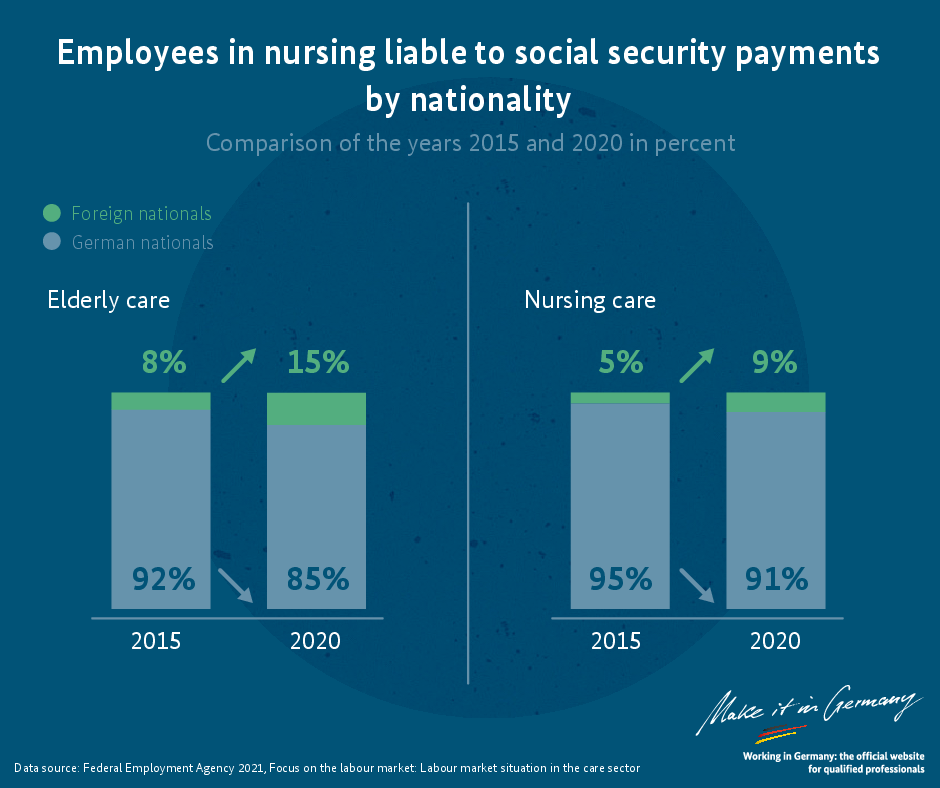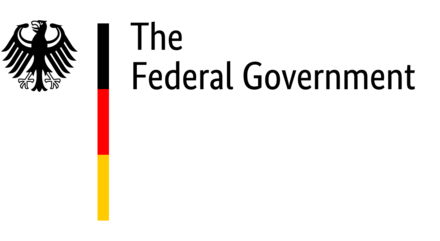Recruiting nursing professionals from abroad for the German labour market
Correct as of: 28.12.2021
The skills gap in nursing has been widening for years. The sector is increasingly reliant on nursing professionals from abroad, especially from non-EU countries – in fact, their numbers now exceed those from EU Member States. In our latest newsletter, we highlight the opportunities employers have to tap into the potential for qualified professionals and young talent abroad, and what they need to consider in the process.
The labour market situation in nursing
More vacancies than unemployed nursing professionals
Statistics from the Federal Employment Agency (BA) reflect what many hospitals and nursing facilities have long felt: there is no mistaking the fact that there are shortages in the nursing sector. The BA classifies both (general) nursing and geriatric care professions as “bottleneck professions” – in all German states, no less[1].
While there are more unemployed people than vacancies at the assistant level, the situation is the opposite at the skilled worker level. The number of unemployed skilled workers in relation to the vacancies that match their qualifications has fallen significantly in recent years. In 2020, there were only 47 unemployed nurses registered for every 100 vacancies that matched their qualifications, compared to 80 unemployed in 2014. In geriatric nursing, the figure has fallen from 38 to only 26 unemployed nursing professionals per 100 registered vacancies in the same period[2].
Growing proportion of qualified professionals from abroad
In the wake of increasing bottlenecks, the nursing sector is increasingly resorting to labour from abroad. In 2020, professionals from abroad accounted for 15% of geriatric nurses (91,000 employees subject to social insurance contributions), a slightly higher figure than that in general nursing (9%, equating to 103,000 employees). Qualified professionals from abroad accounted for around 11% of staff in the entire nursing sector. There has been a marked increase in both areas over the last five years (see figure).

Poland, Bosnia and Herzegovina, Turkey, Croatia and Romania were the top 5 countries of origin of nursing professionals from abroad working in Germany in 2020[3]. The regions of origin highlight the great significance of non-EU countries in particular: around 60 per cent of all nursing professionals from abroad came from countries outside the EU (as of March 2021)[4] In addition, more general nurses from third countries were permitted to work between January and October 2021 (24,400) than in the whole of 2020 (23,100) [5].
Channels for recruiting nursing professionals from abroad
There are essentially two strategies for finding skilled nursing professionals from abroad:
- Employers can train their new recruits themselves. In this case, they must observe the provisions for apprentices from abroad.
- Or they can look for fully qualified skilled workers abroad. In this case, particular attention should be paid to the countries’ different training systems and content.
Hiring apprentices from abroad: which provisions apply?
Special requirements apply to foreign applicants wishing to train as nursing professionals:
- A certificate of intermediate education,
- Knowledge of German: applicants need German language skills at level B1 or B2 according to the Common European Framework of Reference for Languages (CEFR), depending on the federal state where the applicant is to be trained
- Physical aptitude: applicants need a certificate from a German doctor stating that they are physically and mentally healthy and therefore suitable for the profession (this can be provided after entering the country)
- Police Clearance Certificate: a certificate of good conduct from the applicant’s home country or from the German police is required to prove their trustworthiness.
Provisions relating to residence permits
(Future) apprentices from EU or EEA countries can come to Germany without a special residence permit and start their apprenticeship here. Persons from third countries require a visa or a residence permit to complete an apprenticeship in accordance with Section 16a of the German Residence Act (AufenthG). If third-country nationals are currently abroad, they must contact the relevant German mission abroad to apply for a visa to enter Germany.
To obtain a visa or residence permit for vocational training, the following requirements must be met in addition to the aforementioned preconditions for training:
- Proof of an apprenticeship position
- Ability to cover costs of living: Applicants must be able to prove their ability to cover their costs of living. The training allowance is taken into consideration. The guideline values for what is considered to be sufficient financial resources are adjusted and published annually. An apprentice is currently considered to have a secure livelihood if the gross apprenticeship salary is at least €939. Any shortfall can be covered by benefits in kind such as free accommodation or own resources.
Hiring qualified nursing professionals from abroad: what needs to be considered?
When recruiting qualified nursing professionals from abroad, applicants must meet the following requirements:
- Recognition of foreign professional qualifications: The competent authority for the recognition procedure in Germany must check whether the foreign professional qualification – which can also be a university degree – is equivalent to the relevant reference occupation in Germany.
- Professional practice permit: The nursing profession is regulated in Germany. Those wishing to work in a nursing profession in this country therefore need a state licence to practise nursing. As a rule, the following formal requirements must be met:
- Knowledge of German: language skills at level B1 or B2 according to the Common European Framework of Reference for Languages (CEFR), depending on the federal state
- Physical aptitude for the profession: a certificate issued by a German doctor
- Police Clearance Certificate: as proof of trustworthiness and of not having a criminal record.
Visa/residence permit for third-country nationals
Nationals of countries outside the EU/EEA area require a residence permit in order to work in nursing. Depending on the outcome of the recognition procedure, nursing professionals from abroad have two options:
- Work visa for qualified professionals: If the foreign professional qualification has been fully recognised and the competent authority in Germany has agreed to issue a professional practice permit, nursing professionals from third countries can obtain a visa or a residence permit to take up qualified employment in accordance with Section 18a of the German Residence Act (AufenthG). The visa is issued on condition that the applicant has found a specific job as a nursing professional in Germany, in addition to meeting the professional requirements (full recognition and professional practice permit).
- Visa for the recognition of foreign qualifications: If the procedure for professional recognition results in partial recognition, meaning that the candidate attend a qualification programme in Germany, a residence permit for the purpose of recognising a foreign professional qualification in accordance with Section 16d of the German Residence Act (AufenthG) is required. The following requirements must be met to obtain a visa or residence permit in accordance with Section 16d Residence Act:
- Admission to a relevant qualification programme (knowledge test or adaptation period) in Germany
- Knowledge of German at level A2
- Ability to cover costs of living: a blocked account containing at least €11,365 (for the year 2021) or a declaration of commitment.
Successful recruitment from abroad: support and important contact points
Instead of going to the pains of searching for individual nursing professionals abroad themselves, companies can make use of numerous contact points, which will not only help them to fill their nursing vacancies effectively, but also to train and integrate new employees into the company. You will find a selection of contact points and current projects below.
- Interested employers can obtain information from the Central Foreign and Specialized Placement Service (ZAV) of the Federal Employment Agency. There they can also find information about the Triple Win project which supports the placement of nursing professionals from Tunisia, Bosnia and Herzegovina and the Philippines in Germany. New placement agreements were concluded recently with Indonesia[6] and the Indian state of Kerala[7]. In addition, young people from Vietnam with previous experience in nursing are placed in nursing training programmes in Germany.
- The “Faire Anwerbung Pflege” support programme helps employers to recruit nursing professionals from Latin America and Asia. For more information, visit the website of “Projektträger Jülich”.
- The German Agency for International Healthcare Professionals (DeFa) was established in 2019 as a result of the “Concerted Action on Nursing” by the Federal Ministry of Health. DeFa acts as a guide for hospitals, nursing facilities and personnel service agencies, supporting the processes for professional recognition, admission to the labour market, and the entry of nursing professionals from third countries.
More information on “Make it in Germany”
[1] Bundesagentur für Arbeit, Engpassanalyse 2021, available at: https://statistik.arbeitsagentur.de/Statistikdaten/Detail/202012/arbeitsmarktberichte/fachkraefte-engpassanalyse/fachkraefte-engpassanalyse-dl-0-202012-zip.zip?__blob=publicationFile&v=4 .
[2] Unemployment-job ratio, statistics of the Federal Employment Agency in: Blickpunkt Arbeitsmarkt: Arbeitsmarktsituation im Pflegebereich, available at: https://statistik.arbeitsagentur.de/DE/Statischer-Content/Statistiken/Themen-im-Fokus/Berufe/Generische-Publikationen/Altenpflege.pdf?__blob=publicationFile&v=11 .
[3] Bundesagentur für Arbeit 2021, Blickpunkt Arbeitsmarkt: Arbeitsmarktsituation im Pflegebereich, available at: https://statistik.arbeitsagentur.de/SiteGlobals/Forms/Suche/Einzelheftsuche_Formular.html;jsessionid=A9D960A81EB65FB24EEC34FCCF6C118F?nn=27096&topic_f=fachkraefte-engpassanalyse .
[4] Mediendienst Integration, Factsheet: Zuwanderung von Pflegekräften und Ärztinnen & Ärzten, available at: https://mediendienst-integration.de/fileadmin/Dateien/Pflege_Fachkraefte_Ausland_Mediendienst_Factsheet_neu_2021.pdf .
[5] Mediendienst Integration, Factsheet: Zuwanderung von Pflegekräften und Ärztinnen & Ärzten, available at: https://mediendienst-integration.de/fileadmin/Dateien/Pflege_Fachkraefte_Ausland_Mediendienst_Factsheet_neu_2021.pdf ; BA data
[6] Bundesagentur für Arbeit: press release of 27 August 2021, available at: https://www.arbeitsagentur.de/presse/2021-30-pflegekraefte-vermittlungsabsprache-indonesien .
[7] Bundesagentur für Arbeit: press release of 2 December 2021, available at: https://www.arbeitsagentur.de/presse/2021-42-bundesagentur-fuer-arbeit-unterzeichnet-vermittlungsabsprache-mit-dem-indischen-bundesstaat-kerala .
Do you have any questions?
Let us advise you on your opportunities to work and live in Germany. Our experts will support you with questions regarding job search, visa, recognition and learning German.
You can find out more about the various contact options by clicking on one of the icons in the bar below.
